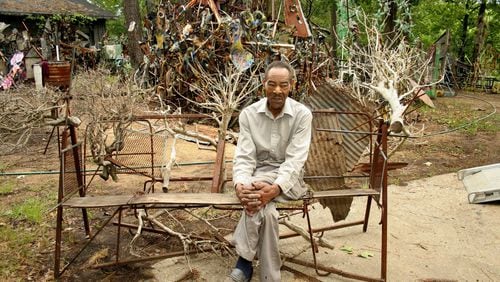A self-taught artist from the “black belt” of Alabama, Thornton Dial worked continuously on his paintings and sculptures, when he wasn’t working at his job fabricating railroad cars.
But rather than let others see his creations, he used to hide or destroy them. It wasn’t modesty, but a sense of self-preservation that inspired caution. Dial’s work was often political. His paintings and sculptures had an “edge,” and his symbolic commentary on the issues of the day — including civil rights — could have brought retribution.
“That sort of edge will let you see the inside of a noose pretty quickly,” said friend Paul Arnett.
After coming to light in 1987, Dial's work would eventually be seen by millions, and collected by major museums, including the Museum of Modern Art in New York; the Whitney Museum of American Art; the Smithsonian American Art Museum; and the High Museum of Art in Atlanta.
It was a great leap from a sharecropper’s shack to the exclusivity of the Whitney Biennial, but Dial was living one of his dictums: “leave something for somebody else.”
Thornton Dial, 87, died Monday at his home in McCalla, Ala.
Katherine Jentleson, Merrie and Dan Boone curator of folk and self-taught art at the High Museum, said Dial helped obliterate the line between folk art and contemporary art. "He demonstrated that the distinctions between insider and outsider, trained and untrained, don't really exist."
The High was the first major museum to collect Dial’s work, starting with a 1995 bequest of 140 works of art from former Georgia Pacific CEO T. Marshall Hahn that included 12 pieces by Dial.
Atlanta is also the home of the Souls Grown Deep Foundation, a nonprofit created by collector and dealer William Arnett that champions African-American art from the South in general and has a substantial cache of Dial's works, donated by Arnett.
In a tribute, published by Souls Grown Deep, William Arnett wrote, “I can’t think of any important artist who has started with less or accomplished more.”
Thornton Dial was born to a poor unwed teenage mother in 1928 in Emelle, Ala., the son and the grandson of sharecroppers. He worked in the fields from the time he was a child, walking in front of his mother and picking cotton as she dragged the sack behind. “We picked cotton when we got big enough to walk,” he said in an autobiographical essay.
In 1941, he was sent off to live with relatives in Bessemer, Ala., an industrial town outside Birmingham known for the production of steel and coal. He left school at age 12, still in the third grade, and learned a wide variety of skills, from carpentry to masonry. Soon he began working as a metal fabricator for the Pullman Standard boxcar company. He would use the welding abilities honed there to create the fantastical sculptural assemblages of found objects that would fill his yard and the outbuildings on his property.
In 1987, fellow Alabama artist Lonnie Holley, in a bid to discover “outsider” artists in the South, sought out Dial, and came away from their first meetings with some fishing lures Dial had fashioned. Those lures attracted Holley’s friend William Arnett.
Like everything else Dial made, the lures had his “aesthetic,” said Arnett’s son, Paul Arnett, chair of the Souls Grown Deep board. “He thought, ‘Surely a fish is going to love these things,’ but as he later said, ‘They’re only good for catching art collectors.’”
They caught William Arnett, who became a Dial collector and developed a proprietary relationship with the artist, paying Dial a stipend for the right of first refusal of his works.
With simultaneous 1993 shows at the Museum of American Folk Art and the New Museum for Contemporary Art, Dial was soon challenging the silo mentality that separated artists into separate worlds.
Works by Dial were bought by collectors such as Hahn and sold at Steve Slotin’s Folk Art auctions, and were exhibited in Atlanta during the run-up to the 1996 Olympics. When Maxwell Anderson, former director of the Michael C. Carlos Museum on the Emory University campus, included Dial in the prestigious Whitney Biennial in 2000, it introduced Dial to a new audience.
“It was a moment in the New York art world, with all of its rituals, to recognize that there was more to life than could be found in the five boroughs of New York City,” Anderson said wryly. “Mr. Dial’s jaunty, wide-ranging curiosity about the world was a new feature to many people.”
In the meantime, Dial’s presence in Atlanta grew. The Freedom Park Conservancy commissioned a 42-foot-long sculptural assemblage, “The Bridge,” honoring U.S. Rep. John Lewis’ civil rights activism, a major work by Dial that was dedicated in 2005 and dominates the intersection of Freedom Parkway and Ponce de Leon Avenue.
He was also commissioned to create a painting for the Atlanta Hawks, which visitors could see as they entered Philips Arena.
Dial and Lewis were friends for many years, and Lewis published a statement Tuesday expressing sorrow at Dial's passing, and admiration for his work. "We are blessed as a nation that we had a chance to appreciate the art of Thornton Dial," Lewis wrote. "He will be deeply missed."
In 2011, after Anderson became director of the Indianapolis Museum of Art, his museum organized a retrospective of Dial's career called "Hard Truths," a show that traveled to New Orleans, Charlotte and Atlanta. The exhibit became a sensation, and a worthy capstone to Dial's efforts.
It also helped to remove that “folk art” asterisk from his name. “When his show traveled the country, that really came through,” Jentleson said. “People were seeing him as one of the most important artists of the 20th century, full stop.”
The surfaces of Dial’s assemblages swirl with coordinated fragments of rags, bones, tin cans — what Jentleson describes as “incredibly hard to manipulate non-art materials.”
The Metropolitan Museum of Art in New York acquired 10 Dial pieces in 2014, donated by Souls Grown Deep. Sheena Wagstaff, the Met’s chair of modern and contemporary art, said, “From the complex, exuberant textures of his assemblages to the deft, fluid lines of his drawings, Dial’s facility as an artist was truly extraordinary.”
Unlike most folk artists, Dial received approbation while he was still alive, Slotin said.
But Paul Arnett said Dial’s legacy has yet to be fully evaluated. “The final appreciation of his work is in its infancy,” he said, “compared to where it will be a generation from now.”







